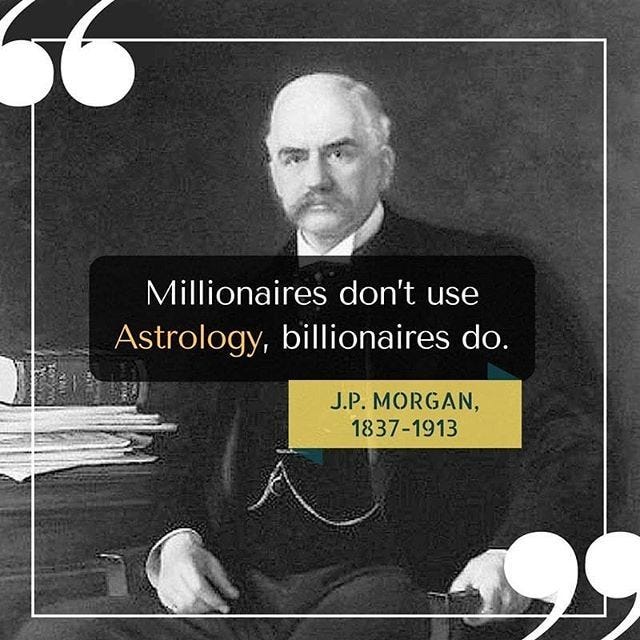
Astrology in Business
Astrology, an ancient and historically significant practice, is often dismissed in modern business environments as mere superstition. However, some of the most successful and influential figures in history, such as J.P. Morgan, saw its potential. Famously stating, “Millionaires don’t use astrology… the billionaires do,” Morgan integrated astrology into his financial decisions, even commissioning a unique pocket watch that displayed planetary positions to guide his investments. This anecdote challenges contemporary perspectives, raising a critical question: why does modern business still resist astrology despite its historical relevance and potential applications?
The Cosmic Perspective: Planetary Influences on Life, Business, and Individual Energies
Few would dispute the profound influence of the Sun on Earth. It regulates ecological systems, dictates seasonal cycles, and sustains life. Similarly, the Moon’s gravitational pull affects ocean tides and aligns with human biological rhythms, such as menstrual cycles. Yet, when considering other celestial bodies like Venus, Mercury, and Jupiter, many remain skeptical.
Consider the observable fact that on a new moon night, when the sky is devoid of moonlight, Venus is capable of casting its own shadow. A simple experiment – placing a pencil upright in the ground – can reveal this planetary light’s tangible effect. Such phenomena prompt us to reconsider the broader implications of planetary influences on human behavior and decision-making.
The reluctance to embrace astrology often stems from its perceived incompatibility with the structured, data-driven paradigms prevalent in contemporary scientific and business practices. Yet, history provides numerous examples of influential individuals leveraging astrological insights, interpreting planetary cycles as patterns that influence human actions, market behaviors, and socio-economic shifts.
Scientific Connections: Quantum Physics, Human Frequencies, and Planetary Pulsations
Modern physics introduces concepts that could reshape our understanding of astrology and human energy patterns. Quantum phenomena such as superposition and entanglement suggest that particles, and potentially planetary bodies, may affect each other despite vast distances. This aligns with astrological concepts, where planetary alignments are believed to influence human psychology, collective behavior, and even individual frequencies.
Moreover, human-centered systems like Human Design, BG5, and OC16 offer a modern framework for understanding individual energetic patterns. These methods reveal the underlying frequencies of human beings, providing insights into career growth, authentic leadership, team dynamics, and personalized communication strategies. Such insights in-power individuals to harness their innate strengths, moving beyond mere functional skillsets to align their professional lives with their energetic makeup.
Furthermore, quantum theory posits that particles do not exist in one definitive state until observed, remaining instead in a superposition of potential states. Could it be that human consciousness, influenced by planetary alignments, also oscillates among potential outcomes, shaped by the surrounding cosmic context? The concept of entanglement, wherein particles instantaneously influence one another regardless of distance, mirrors the astrological notion of interconnected planetary influences and the Human Design concept of interconnectedness within teams.
Another compelling example is the phenomenon known as ‘Star in a Jar,’ where sound waves create light within a vacuum, highlighting the interplay between frequency and energy. Stars, including planets, emit specific frequencies that manifest as pulsations. These frequencies, reminiscent of musical harmonies, evoke Tesla’s famous insight: “If you want to find the secrets of the universe, think in terms of energy, frequency, and vibration.” It is plausible that the unique vibrational patterns of planets influence earthly dynamics in ways not yet fully quantified.
The Particle Reality: Quantum Particles, Human Energetics, and Cosmic Interactions
The Standard Model of particle physics identifies 17 elementary particles: 12 fermions (6 quarks and 6 leptons) and 5 bosons, which mediate fundamental forces. Fermions constitute matter, while bosons act as force carriers, enabling interactions. The universe itself comprises visible matter (4.9%), dark matter (26.8%), and dark energy (68.3%). These proportions imply that most of the universe’s structure remains beyond direct observation.
If the majority of the universe consists of dark matter and dark energy—mysterious components that defy direct detection—could planetary movements influence these unseen forces? From this perspective, astrology might offer a symbolic interpretation of cosmic interactions, reflecting vibrational patterns that shape human experiences. Similarly, Human Design’s energetic profiling aligns with this idea, suggesting that human frequencies may resonate differently based on cosmic influences.
Why Astrology Remains Taboo in Business Contexts
Despite its potential, astrology remains marginalized in professional settings due to the dichotomy between empirical science and interpretive methods. Businesses that prioritize data-driven strategies may find it challenging to integrate a practice that resists quantitative validation.
However, Human Design, BG5, and OC16 bring a practical dimension to understanding human potential by highlighting intrinsic strengths and alignment patterns. These insights facilitate individualized leadership approaches, enhance team dynamics, and improve communication by respecting diverse energy types within teams. Such in-powered leadership fosters environments where individuals thrive through their natural frequencies rather than conforming to traditional hierarchical models.
Integrating Astrology and Human Design into Contemporary Business Practice
Rather than outright dismissal, business leaders could benefit from a balanced approach to astrology and Human Design. By aligning decisions with natural cycles and recognizing individual energy patterns, leaders might enhance their strategic planning and intuitively align with broader patterns. Viewing astrology and human-centric energetics as interpretative frameworks rather than rigid predictive tools can offer novel insights into organizational rhythms and human potential.
The universe’s inherent vibrations and pulsations suggest that energy and frequency permeate all existence, shaping outcomes in subtle yet significant ways. Acknowledging these influences can enrich leadership practices, fostering a more holistic approach to decision-making. As science continues to explore the fundamental nature of reality, integrating ancient wisdom with modern understanding may provide a multidimensional strategy for business success.
In an age dominated by data and logic, revisiting astrology and Human Design through the lens of scientific discovery could redefine their role in strategic thinking. As research deepens our grasp of cosmic interconnectivity and human energetics, these practices might emerge not as relics of the past but as vital tools for navigating the complexities of modern enterprise.
Closing Thoughts: Unlock Your Leadership Potential
Astrology and Human Design offer powerful frameworks to understand human behavior, leadership dynamics, and organizational rhythms. By integrating ancient wisdom with modern science, you can unlock new dimensions of strategic thinking, decision-making, and team alignment.




0 Comments